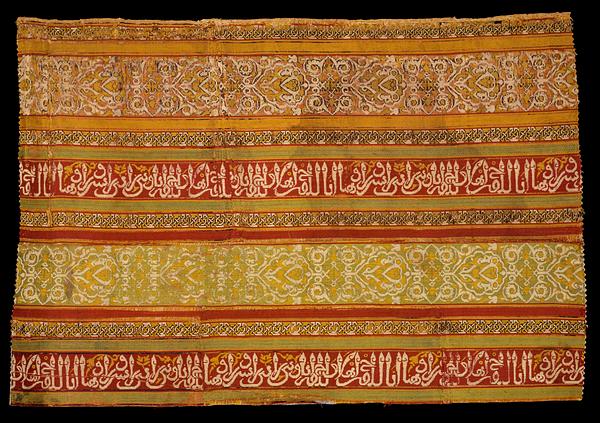Lampas-woven textile, silk
Spain, Andalusia; late 14th-early 15th century
H: 36; W: 53 cm
“I exist for pleasure, welcome, for pleasure I am; each one who sees me sees joy and wellbeing.” This repeated, self-indulgent verse in Arabic corresponds quite well to the mood that must have prevailed in Nasrid Granada – part of the Islamic world that had to accept that it would be incorporated into Christian Spain at any time.
Writing has always been an important part of Islamic textile design. The early tiraz inscriptions often had a political content, but later they frequently took on a poetical or religious character. On this charming fragment, inscription bands alternate with arabesques and interlacing sections.
Inv. no. 2/1989
Published in:
Adèle Coulin Weibel: 2000 years of silk weaving, New York 1944, part of cat. 137 and pl. 38;
Donald King: Textiles from the Sangiorgi Collection, Spink & Son, London 1985, cat. 6;
Kjeld von Folsach: Islamic art. The David Collection, Copenhagen 1990, cat. 398;
Kjeld von Folsach and Anne-Marie Keblow Bernsted: Woven Treasures: Textiles from the World of Islam, The David Collection, Copenhagen 1993, cat. 19;
Kjeld von Folsach, Torben Lundbæk and Peder Mortensen (eds.): Sultan, Shah and Great Mughal: the history and culture of the Islamic world, The National Museum, Copenhagen 1996, cat. 198;
Kjeld von Folsach: Art from the World of Islam in The David Collection, Copenhagen 2001, cat. 645;
Sheila S. Blair and Jonathan M. Bloom (eds.): Cosmophilia. Islamic Art from the David Collection, Copenhagen, McMullen Museum of Art, Boston College, Boston 2006, cat. 109;
Joachim Meyer, Rasmus Bech Olsen and Peter Wandel: Beyond words: calligraphy from the World of Islam, The David Collection, Copenhagen 2024, cat. 69, p. 213;
